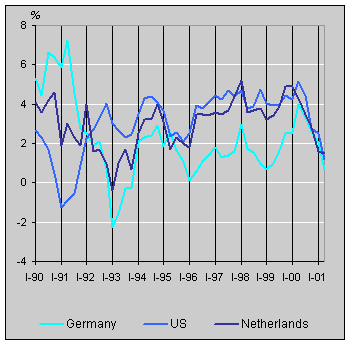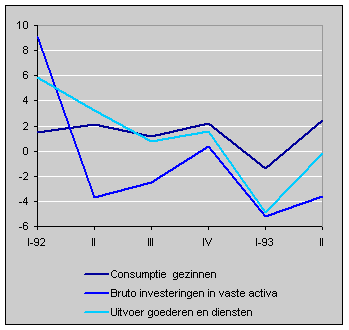The economic dip in the early nineties

Economic growth has tumbled from nearly five to one and a half percent in the space of six quarters. The last time that such a rapid decline took place was nine years ago. Analysis of the two periods reveals both similarities and differences.
Similarities
Just as in 2000, in the course of 1992 growth rates of international trade and investment declined and consumers started to borrow less and save more. In the manufacturing industry activity decreased sharply in both periods, selling prices of manufactured products increased more slowly or even decreased, and producers’ confidence started lagging. Consumers, too, became more pessimistic in this period.
Economic growth Netherlands, Germany and US

Economic growth: parallels and contrasts
The most noticeable difference between the two periods is in the course of economic growth of the Netherlands, Germany and the United States. From 1996 to 2000 the developments are parallel for the three countries, although German economic growth was 2 percentage points lower than the other two countries. From mid 2000 the figures are closer together. This is in sharp contrast with economic growth in the first half of the nineties. The effects of the reunification pushed up German growth to high levels in 1990 and 1991, while in the US growth slipped intro recession. Once the spending impulse of the reunification had petered out in mid 1992, Germany also went into a delayed recession. In the Netherlands the sharp fall in the course of 1992 can indeed be regarded as the final stage in a longer period of economic recession, which had started in the first quarter of 1990. This fall stopped temporarily in 1991 because of the positive economic impulses of the German reunification on industrial activity in the Netherlands.
Household consumption, investment and exports

Labour and wage developments
We can see that the rapid decline in the Netherlands after the beginning of 1992 was part of a longer period of decreasing growth when we compare developments on the labour market and in wages. Registered unemployment, for example, rose by 65 thousand in 1992 and the first half of 1993. The number of vacancies fell by 45 thousand in the same period and the rate of wage increases also slowed down. Up to now these developments have not been seen in the period since the beginning of 2000. Unemployment has fallen by 85 thousand, the number of vacancies has risen by 15 thousand and wage increases have been accelerating.
Partly because of the preceding recovery in the US, the economic dip in the Netherlands after the first quarter of 1992 remained limited. Exports and household spending recovered first. In the second quarter of 1993 the economy grew by 1% again. Remarkably, the confidence of producers and consumers improved only later. The underlying differences between the two periods and the dramatic events in America on 11 September make it difficult to give any estimation of how long the present dip will last.
Frans van Ingen Schenau